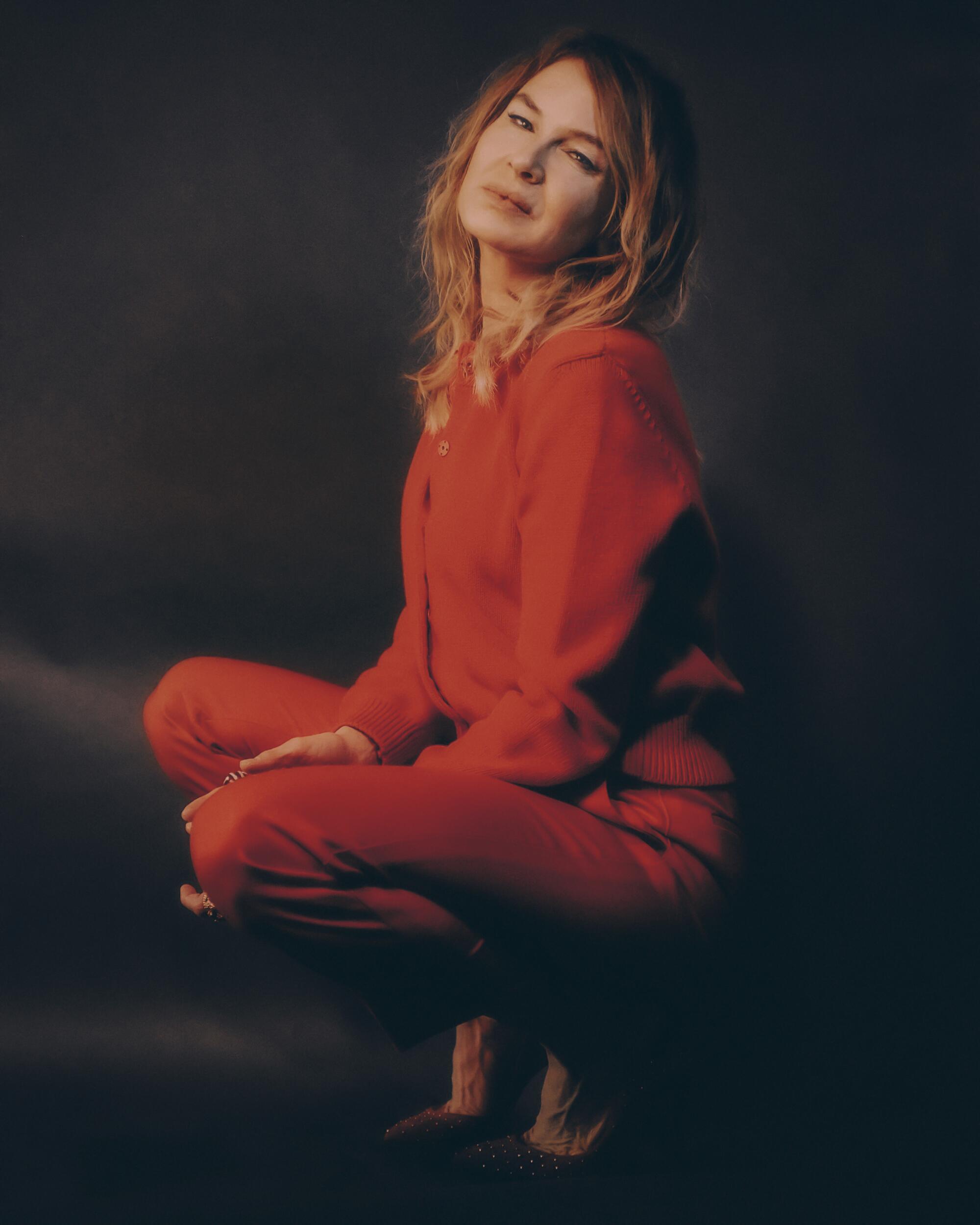- Share via

Renée Zellweger is finishing up a photo shoot in an old Hollywood hotel just up the street from the Ravenswood Apartments where she lived when she first came to town 30 years ago. She’s glammed up for the shoot, but she’s here to talk about one of the least glamorous characters she’s ever played: Pam Hupp.
In “The Thing About Pam,” Zellweger checked her lithe beauty at the door to become the stocky, kooky, soda-slurping Missouri woman who was convicted of murder in 2019 and has since been charged with another. Hupp was the subject of several “Dateline” episodes and an ancillary podcast, which served as source material for the six-part Hulu series.
“It’s my favorite, anti-glamour,” Zellweger says.
It was the first role she took after winning an Oscar as Judy Garland in “Judy.” There was nothing calculated about that sequence of events, she just knew she wanted “to have a job that was of a different intensity. And this was very much that. It was not less intense, just different.”
Much attention has been on the fat suit and facial prosthetics that plumped Zellweger into an almost unrecognizable doughy Midwestern mom. It’s easy to overlook the subtler transformations she made: the little sniffs and the glaring eyes, the way she pursed her mouth and contorted her lips around Hupp’s slippery accent.
“It seems like it’s an amalgam from a lot of different places,” says Zellweger, who watched footage of Hupp’s court appearances and depositions and recorded clips of herself saying dialogue in Hupp’s voice, which she listened to on repeat. “It wasn’t straight Midwestern, or straight Southern. She spent some time in Florida, and sounded sometimes like she’s from Wisconsin or Minnesota or something.”
She also noticed how Hupp would “speak really quickly when she’s trying to gloss over something and move onto the next subject, when she doesn’t want to elaborate or if she feels like she’s in a corner in terms of where she’s taking the story.”

In Zellweger’s performance, Hupp is self-assured, devious, passive-aggressive and often cold as ice in the way she almost gleefully abuses the people in her life. She manipulates her friend, Betsy Faria, whose brutal murder kicks off the narrative. She manipulates the investigation, which leads to the conviction of Faria’s husband. The character is always, herself, acting — or is she?
“You have to ask the question about whether or not she’s cognizant of that,” Zellweger says. “Like, is that her truth? Is what she’s saying real to her, you know?”
She identified in Hupp a woman driven by survival and an unquenchable love of money. She relied on the narrative of events that Hupp presented and the information she volunteered, as well as insights from friends and family members to create her version of Hupp.
“That felt the most respectful way to go forward,” Zellweger says, “was to not stray too far from what she herself put on the record.”
That also determined the series’ offbeat tone: narrated cheekily by “Dateline” correspondent Keith Morrison, it plays as a black comedy somewhat in the vein of a Coen brothers film. There’s an intentional broadness to Zellweger’s performance, a larger-than-life lie-spinner who at times almost seems aware of the fourth wall. It was NBC’s top series launch this season and the network’s top digital launch ever.
The tone was consistent with the inherent bizarreness in Hupp’s account of what happened. What’s most shocking about this story, Zellweger says, “is the series of escalating absurdities that led to the conviction of the wrong person. And you ask yourself: How could that happen? And as you start to peel back the layers of information, and what Pam herself presented as the narrative, you recognize that, well, it is the absurdity within her telling of the story that makes this case so unusual. Because if you look at it literally, it seems impossible that anyone would take it seriously. It felt important that the tone allow for that.”
A quick glance at Zellweger’s résumé turns up a lot of murder: “A Taste for Killing,” “Murder in the Heartland,” “Deceiver,” “Nurse Betty,” “White Oleander,” “Chicago” ...
“What’s your point?” she says, her whisper-quiet voice exploding into laughter.

She admits she has her own “boring dinner table theories” about why we’re so fascinated with the subject, and particularly true crime stories: “We’ve always been fascinated by the macabre as humans, right? Truth is stranger than fiction. And then I wonder if it’s more part of a survival mechanism, subconsciously. Especially when it’s something that deviates from what traditionally defines normalcy for us, we’re fascinated by it, and we want to better understand it, thinking perhaps that if we understand the bad thing, that then somehow we can avoid it.”
“Pam” was filmed across four months in the winter of 2021. It was only the second “small screen” project the movie star has ever done, and she enjoyed the quick and scrappy pace.
The long form meant “you can explore the material a bit more comprehensively,” she says. “But you’re doing it at a clip — so there’s a lot of running around, and there’s not a lot of time to know exactly what it is that you’re trying to achieve. You have very little time to discover something in the moment. You really have to be disciplined about knowing what you want.
“Not to say that there’s not room for a little bit of accidental magic — because there always is.”
More to Read
Sign up for The Envelope
Get exclusive awards season news, in-depth interviews and columnist Glenn Whipp’s must-read analysis straight to your inbox.
You may occasionally receive promotional content from the Los Angeles Times.






